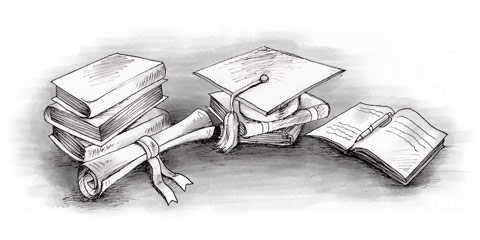Around 90 percent of students in the United States complete high school and the US also has a higher percentage of college graduates (over 50 percent) than many countries. Many American universities and other higher education institutions are internationally renowned (the US arguably has the best undergraduate education system in the world) and their student bodies include thousands of foreign students from all corners of the globe.
Full-time education is compulsory in all states and includes the children of foreign nationals permanently or temporarily residing in the US for a minimum of one year. All children, regardless of their parent’s legal status, have the right to enroll in school in the US. Compulsory schooling usually commences at the age of six and continues until between 14 and 18 depending on the state. The typical American receives 12 years of education (known as K-12), although the average is lower in rural areas and small towns (apart from university towns), and higher in metropolitan areas.
Public and private schools in the US
There’s no federal education system in the US, where education is primarily the responsibility of individual states and districts. Consequently, education standards and requirements vary considerably from state to state and district to district. Because schools rely heavily on property taxes for funding, it is usually the case that higher income districts have better schools. No fees are payable in public (state) primary and secondary schools, which are attended by around 90 percent of children (schoolchildren of all ages are usually referred to as students). The other 10 percent attend private fee-paying schools, most of which are church-sponsored (often Roman Catholic) parochial schools. The number of students enrolling in private schools has been decreasing for the last two decades .
There’s also a growing trend (an increase of 15 percent per year) for children to be educated at home and it’s estimated that some 2 to 3 million Americans (3 percent of the school-age population) are taught by parents at home or in communal classes.
Education levels
Formal education comprises three levels: elementary, secondary and higher. Secondary school usually consists of middle school (grades 6-8) and high school (grades 9-12). Vocational training, adult education, and special schools or classes also form part of the education programme in most states. Many states and communities provide schools or special classes for children with special educational needs , including those with emotional and behavioral problems, moderate and severe learning difficulties, communication problems, partial hearing or physical disabilities. There are also private schools catering for gifted and talented children, and most public schools have gifted and talented programs.
Separation of state and religion
The US constitution requires the separation of state and religion and forbids religious observance in public schools (although there are plans to restore school prayers in some areas), but children are still expected to participate in the ritual morning pledge of allegiance to the American flag in many schools (although the words ‘under God’ are optional!). With the exception of a few private schools, school uniforms are rare, although they’re becoming more popular at charter schools, particularly in large cities.
A unique aspect of the US education system is the high degree of parental involvement. ‘Parent power’ isn’t only accepted, but is welcomed and encouraged through local Parent Teacher Associations (PTAs) and Home and School Associations (HSAs) attached to every school. PTAs and HSAs meet regularly and concern themselves with many aspects of a school’s affairs including the curriculum, facilities, school hours and after-school activities and programmes. Parents are encouraged to attend meetings and show an interest in the school and their children’s education (it’s also a good way for newcomers to make friends). Schools organize parent days, ‘back to school’ nights and parent-teacher conferences, where parents can meet teachers and examine their child’s school timetable.
Educational standards in the US
In the last decade or so, there has been extensive debate over the declining standards and low achievements of American students, particularly when compared with students in other leading industrialized countries such as Germany and Japan. In tests given to American and foreign students, the US has had a poor showing. American high school students and graduates (from public and private schools) ranked 31st worldwide in math, science and reading. To address this, the federal government has introduced standardized testing in schools to measure achievement and to distribute funds accordingly. Parents can take a look at schools’ average scores on these tests to get an idea of how they compare.
In recent years, many parents concerned about the decline in public education have turned to private schools. Although the cost of private education is high, many American parents consider it an acceptable price to pay, particularly if the outcome is a bachelor’s or master’s degree from a prestigious university, with its resulting monetary value in the job market. Education for its own sake or the love of learning is rare in the US, where education and qualifications are judged primarily on their earning power (particularly MBAs ). Foreign families resident in the US for a short period may prefer to send their children to a private international school, where they will be less immersed in American ways. The organisation and curricula of most private schools and colleges are similar to those of public schools, although the administration differs.
Schools for foreigners in the US
Around one in five children enrolled in public schools speak another language than English at home. If your child doesn’t speak English fluently, inquire whether English as a Second Language (ESL) classes are available or whether study is available in other languages. Most states have ESL programs, especially in areas with large immigrant populations. In most states, children also have the option of learning a foreign language, with Spanish being the most common. Other foreign languages commonly studied in the US primary and secondary schools are French, German and Japanese.
Adapted from Living and Working in America.


